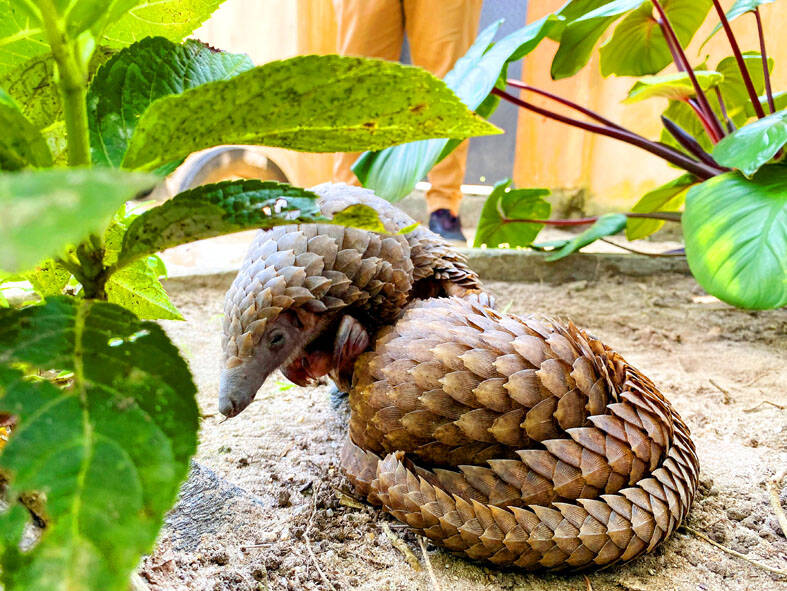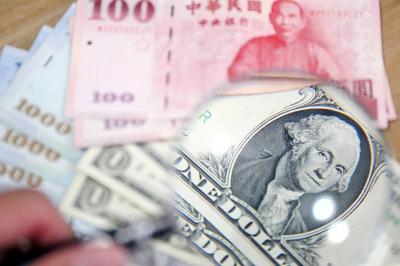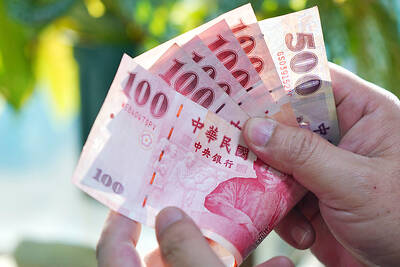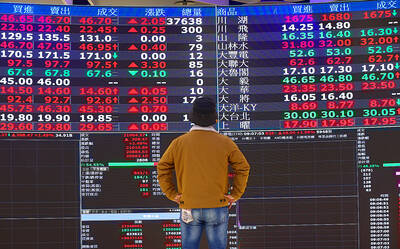Even as human-caused climate change threatens the environment, nature continues to inspire our technological advancement.
“The solutions that are provided by nature have evolved for billions of years and tested repeatedly every day since the beginning of time,” University of Edinburgh researcher Evripidis Gkanias said.
Gkanias has a special interest in how nature can educate artificial intelligence.

Photo: Reuters
“Human creativity might be fascinating, but it cannot reach nature’s robustness — and engineers know that,” he said.
From compasses mimicking insect eyes to forest firefighting robots that behave like vines, here is a selection of this year’s nature-based technology.
Some insects — such as ants and bees — navigate visually based on the intensity and polarization of sunlight, thus using the sun’s position as a reference point. Researchers replicated their eye structure to construct a compass capable of estimating the sun’s location in the sky, even on cloudy days.
Common compasses rely on Earth’s weak magnetic field to navigate, which is easily disturbed by noise from electronics.
A prototype of the light-detecting compass is “already working great,” said Gkanias, who led the study published in Communications Engineering.
“With the appropriate funding, this could easily be transformed into a more compact and lightweight product” freely available, he added.
With a little further tweaking, the insect compass could work on any planet where a big celestial light source is visible.
Fabric inspired by the silky threads of a spider web and capable of collecting drinking water from morning mist could soon play an important role in regions affected by water scarcity.
The artificial threads draw from the feather-legged spider, whose intricate “spindle-knots” allow large water droplets to move and collect on its web.
Once the material can be mass produced, the water harvested could reach a “considerable scale for real application,” said Zheng Yongmei (鄭?梅), a coauthor of the study published in Advanced Functional Materials.
Animals are not the only source of inspiration from nature.
Scientists have created an inflatable robot that “grows” in the direction of light or heat, in the same way vines creep up a wall or across a forest floor. The about 2m-long tubular robot can steer itself using fluid-filled pouches rather than costly electronics.
In time, the robots could find hot spots and deliver fire suppression agents, researchers at the University of California, Santa Barbara say.
“These robots are slow, but that is OK for fighting smoldering fires, such as peat fires, which can be a major source of carbon emissions,” coauthor Charles Xiao said.
Before the robots can climb the terrain, they need to be more heat-resistant and agile.
Scientists at the Unconventional Computing Laboratory at the University of the West of England in Bristol have found a way to use slimy kombucha mats — produced by yeast and bacteria during the fermenting of the popular tea-based drink — to create “kombucha electronics.”
The scientists printed electrical circuits onto dried mats that were capable of illuminating small LED lights.
Dry kombucha mats share properties of textiles or even leather, but they are sustainable and biodegradable, and can even be immersed in water for days without being destroyed, the authors said.
“Kombucha wearables could potentially incorporate sensors and electronics within the material itself, providing a seamless and unobtrusive integration of technology with the human body,” such as for heart monitors or step-trackers, lead author and laboratory director Andrew Adamatzky said.
The mats are lighter, cheaper and more flexible than plastic, but the authors caution that durability and mass production remain significant obstacles.
Pangolins resemble a cross between a pine cone and an anteater. The soft-bodied mammals, covered in reptilian scales, are known to curl up in a ball to protect themselves against predators.
Now, a tiny robot might adapt that same design for potentially lifesaving work, a study published in Nature Communications showed.
It is intended to roll through our digestive tracts before unfurling and delivering medicine or stopping internal bleeding in hard-to-reach parts of the human body.
Lead author Soon Ren Hao of the Max Planck Institute for Intelligent Systems was watching a YouTube video when he “stumbled across the animal and saw it was a good fit.”
Soon needed a soft material that would not cause harm inside the human body, with the advantages of a hard material that could, for example, conduct electricity. The Pangolin’s unique structure was perfect.
The tiny robots are still in their initial stages, but they could be made for as little as 10 euros (US$11.03) each.
“Looking to nature to solve these kinds of problems is natural,” Soon said. “Every single design part of an animal serves a particular function. It’s very elegant.”

The US dollar was trading at NT$29.7 at 10am today on the Taipei Foreign Exchange, as the New Taiwan dollar gained NT$1.364 from the previous close last week. The NT dollar continued to rise today, after surging 3.07 percent on Friday. After opening at NT$30.91, the NT dollar gained more than NT$1 in just 15 minutes, briefly passing the NT$30 mark. Before the US Department of the Treasury's semi-annual currency report came out, expectations that the NT dollar would keep rising were already building. The NT dollar on Friday closed at NT$31.064, up by NT$0.953 — a 3.07 percent single-day gain. Today,

‘SHORT TERM’: The local currency would likely remain strong in the near term, driven by anticipated US trade pressure, capital inflows and expectations of a US Fed rate cut The US dollar is expected to fall below NT$30 in the near term, as traders anticipate increased pressure from Washington for Taiwan to allow the New Taiwan dollar to appreciate, Cathay United Bank (國泰世華銀行) chief economist Lin Chi-chao (林啟超) said. Following a sharp drop in the greenback against the NT dollar on Friday, Lin told the Central News Agency that the local currency is likely to remain strong in the short term, driven in part by market psychology surrounding anticipated US policy pressure. On Friday, the US dollar fell NT$0.953, or 3.07 percent, closing at NT$31.064 — its lowest level since Jan.

The New Taiwan dollar and Taiwanese stocks surged on signs that trade tensions between the world’s top two economies might start easing and as US tech earnings boosted the outlook of the nation’s semiconductor exports. The NT dollar strengthened as much as 3.8 percent versus the US dollar to 30.815, the biggest intraday gain since January 2011, closing at NT$31.064. The benchmark TAIEX jumped 2.73 percent to outperform the region’s equity gauges. Outlook for global trade improved after China said it is assessing possible trade talks with the US, providing a boost for the nation’s currency and shares. As the NT dollar

The Financial Supervisory Commission (FSC) yesterday met with some of the nation’s largest insurance companies as a skyrocketing New Taiwan dollar piles pressure on their hundreds of billions of dollars in US bond investments. The commission has asked some life insurance firms, among the biggest Asian holders of US debt, to discuss how the rapidly strengthening NT dollar has impacted their operations, people familiar with the matter said. The meeting took place as the NT dollar jumped as much as 5 percent yesterday, its biggest intraday gain in more than three decades. The local currency surged as exporters rushed to